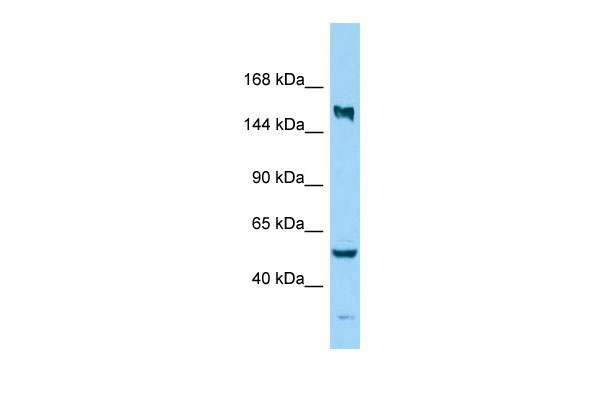KIF24 Antibody - C-terminal region
Rabbit Polyclonal Antibody
- SPECIFICATION
- CITATIONS
- PROTOCOLS
- BACKGROUND

Application
| WB |
|---|---|
| Primary Accession | Q5T7B8 |
| Other Accession | NM_194313, NP_919289 |
| Reactivity | Human |
| Predicted | Human |
| Host | Rabbit |
| Clonality | Polyclonal |
| Calculated MW | 151kDa |
| Gene ID | 347240 |
|---|---|
| Alias Symbol | C9orf48, bA571F15.4 |
| Other Names | Kinesin-like protein KIF24, KIF24, C9orf48 |
| Format | Liquid. Purified antibody supplied in 1x PBS buffer with 0.09% (w/v) sodium azide and 2% sucrose. |
| Reconstitution & Storage | Add 50 ul of distilled water. Final anti-KIF24 antibody concentration is 1 mg/ml in PBS buffer with 2% sucrose. For longer periods of storage, store at 20°C. Avoid repeat freeze-thaw cycles. |
| Precautions | KIF24 Antibody - C-terminal region is for research use only and not for use in diagnostic or therapeutic procedures. |
| Name | KIF24 |
|---|---|
| Synonyms | C9orf48 |
| Function | Microtubule-dependent motor protein that acts as a negative regulator of ciliogenesis by mediating recruitment of CCP110 to mother centriole in cycling cells, leading to restrict nucleation of cilia at centrioles. Mediates depolymerization of microtubules of centriolar origin, possibly to suppress aberrant cilia formation (PubMed:21620453). Following activation by NEK2 involved in disassembly of primary cilium during G2/M phase but does not disassemble fully formed ciliary axonemes. As cilium assembly and disassembly is proposed to coexist in a dynamic equilibrium may suppress nascent cilium assembly and, potentially, ciliar re-assembly in cells that have already disassembled their cilia ensuring the completion of cilium removal in the later stages of the cell cycle (PubMed:26290419). Plays an important role in recruiting MPHOSPH9, a negative regulator of cilia formation to the distal end of mother centriole (PubMed:30375385). |
| Cellular Location | Cytoplasm, cytoskeleton, microtubule organizing center, centrosome, centriole. Cytoplasm, cytoskeleton, microtubule organizing center, centrosome Note=Primarily localizes to the mother centriole/basal body and is either absent at daughter centriole |

Thousands of laboratories across the world have published research that depended on the performance of antibodies from Abcepta to advance their research. Check out links to articles that cite our products in major peer-reviewed journals, organized by research category.
info@abcepta.com, and receive a free "I Love Antibodies" mug.
Provided below are standard protocols that you may find useful for product applications.
References
Humphray S.J.,et al.Nature 429:369-374(2004).
Ota T.,et al.Nat. Genet. 36:40-45(2004).
Daub H.,et al.Mol. Cell 31:438-448(2008).
Oppermann F.S.,et al.Mol. Cell. Proteomics 8:1751-1764(2009).
Kobayashi T.,et al.Cell 145:914-925(2011).
If you have used an Abcepta product and would like to share how it has performed, please click on the "Submit Review" button and provide the requested information. Our staff will examine and post your review and contact you if needed.
If you have any additional inquiries please email technical services at tech@abcepta.com.













 Foundational characteristics of cancer include proliferation, angiogenesis, migration, evasion of apoptosis, and cellular immortality. Find key markers for these cellular processes and antibodies to detect them.
Foundational characteristics of cancer include proliferation, angiogenesis, migration, evasion of apoptosis, and cellular immortality. Find key markers for these cellular processes and antibodies to detect them. The SUMOplot™ Analysis Program predicts and scores sumoylation sites in your protein. SUMOylation is a post-translational modification involved in various cellular processes, such as nuclear-cytosolic transport, transcriptional regulation, apoptosis, protein stability, response to stress, and progression through the cell cycle.
The SUMOplot™ Analysis Program predicts and scores sumoylation sites in your protein. SUMOylation is a post-translational modification involved in various cellular processes, such as nuclear-cytosolic transport, transcriptional regulation, apoptosis, protein stability, response to stress, and progression through the cell cycle. The Autophagy Receptor Motif Plotter predicts and scores autophagy receptor binding sites in your protein. Identifying proteins connected to this pathway is critical to understanding the role of autophagy in physiological as well as pathological processes such as development, differentiation, neurodegenerative diseases, stress, infection, and cancer.
The Autophagy Receptor Motif Plotter predicts and scores autophagy receptor binding sites in your protein. Identifying proteins connected to this pathway is critical to understanding the role of autophagy in physiological as well as pathological processes such as development, differentiation, neurodegenerative diseases, stress, infection, and cancer.


